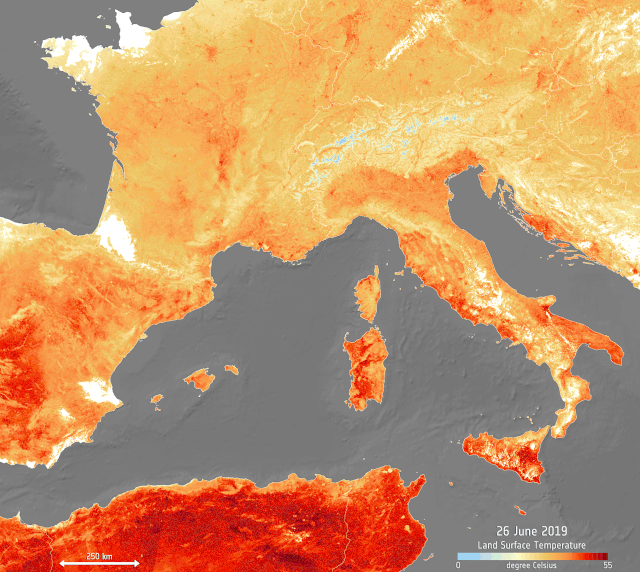
The heat wave bearing over Europe is visible from space, a team creates the first picture of "spooky" quantum entanglement and the sky appeared to be split in two thanks to an optical effect. These are just some of the top photos this week at Space.com.
1. First Photo of 'Spooky' Quantum Entanglement

Albert Einstein once described quantum entanglement as a ''spooky action at a distance," and this first-ever photo of the phenomenon does inspire the heebie jeebies. To take the photo, a team at the University of Glasgow had to entangle light particles, called photons, by hitting a crystal with an ultraviolet (UV) laser. This caused some of those photons from the laser to break apart into two photons.
2. Heat Wave in Europe

The record-breaking heat wave sweeping across Europe is visible in this animation based on data from the Copernicus program of the European Union. This imagery, created from data collected by the Copernicus Sentinel-3's sea and land surface temperature radiometer, shows the hot temperatures on July 25 and compares them to the previous heat wave and its most sweltering day, June 26, 2019. Regions like the Netherlands, Belgium and Germany have been struck hard, and Paris recently reached 105 degrees Fahrenheit (41 degrees Celsius).
3. Split Screen Sunset

Image credit: Photo courtesy of Uma Gopalakrishnan
The sunset appears to be split into two different skies thanks to a particular optical effect. Uma Gopalakrishnan captured this photo on July 13 in Charlotte, North Carolina. This visual can be produced when an object, like a large cloud, lies between the sun and clouds that are closer to the ground and casts a shadow. The split screen appearance is a result of direct sunlight getting blocked and not reaching other clouds, according to Universities Space Research Association.
4. Used SpaceX Falcon 9 Lift Off

A view of a used SpaceX Falcon 9 rocket lifting off from its launchpad on July 25. The Falcon 9 rocket is about 230 feet (70 meters) tall and can launch 50,265 lbs. (22,800 kg) of payload into orbit. The rocket brought a Dragon cargo ship to the International Space Station to deliver 5,000 lbs. of NASA supplies to the orbiting laboratory's Expedition 60 crew. When loaded for launch, SpaceX's Dragon weighs 13,228 lbs. (6,000 kg), according to SpaceX specs. - Tariq Malik
5. Medallion Floating in Space

Image credit: Luca Parmitano/ESA/Twitter
A medallion from the European Astronaut Centre floats in microgravity in front of an Earth-facing window of the International Space Station. ESA astronaut Luca Parmitano tweeted the photo from space on Thursday (Aug. 1). The medallion launches with all European astronauts, Parmitano said, adding that this tradition started after his first mission in 2013. He returned to the orbiting laboratory on July 20. "I took it with me – proudly - for the first time," he said. - Hanneke Weitering
6. Meteor Over Mount Rainier

Image credit: Tony Corso
A meteor, Jupiter and the Milky Way galaxy light up the night sky above the snow-capped Mount Rainier in Washington state in this stunning image by astrophotographer Tony Corso. He captured the photo during the peaks of two dueling meteor showers, the Southern Delta Aquariids and the Alpha Capricornids on July 29. - Hanneke Weitering
7. Moon Plays 'Peekaboo' with Earth

NASA astronaut Nick Hague tweeted this photo of a nearly-full moon setting behind the Earth as a fluffy sheet of clouds covers the land below. A few snow-capped mountains can be seen through a break in the clouds to the bottom right of the image. (Hague did not specify which mountain range is in the photo.) - Hanneke Weitering
8. SPECULOOS Spots a Strange Galaxy

Image credit: ESO/SPECULOOS Team/E. Jehin
The oddly shaped galaxy Centaurus A glistens in deep space in this view from the European Space Agency's new SPECULOOS observatory in Chile. This was one of the "first light" images from SPECULOOS (which stands for "Search for habitable Planets EClipsing ULtra-cOOl Stars"). Centaurus A, also known as NGC 5128, is one of the brightest objects in the night sky of the Southern Hemisphere. It's located 11 million light-years from Earth in the constellation of Centaurus. Astronomers believe that Centaurus A was once an elliptical galaxy that collided with a small spiral galaxy, and that this collision is responsible for the galaxy's irregular shape. - Hanneke Weitering
9. SpaceX Aces Another Landing

Image credit: SpaceX
A SpaceX Falcon 9 rocket touches down on Landing Zone 1 at Cape Canaveral Air Force Station in Florida after launching a Dragon cargo spacecraft to the International Space Station. The rocket lifted off July 25 at 6:01 p.m. EDT (2201 GMT) and delivered the cargo craft into orbit before returning to Earth. More than 5,000 lbs. (2,268 kilograms) of crew supplies and science experiments were packed inside the Dragon, which is scheduled to arrive at the space station on Saturday. - Hanneke Weitering
10. A Spiral Galaxy's Edge

Image credit: ESA/NASA/Hubble/A. Filippenko/R. Jansen; CC BY 4.0
What looks like a long, narrow stretch of stars in this Hubble Space Telescope image is actually a spiral galaxy just like the Milky Way. From our position in the cosmos, we view this galaxy edge-on. Named NGC 3432, this galaxy is located about 45 million light-years from Earth in the constellation of Leo Minor. - Hanneke Weitering
Top image: Edited Hubble Space Telescope image of the spiral galaxy (seen edge-on) NGC 3432 with lots of red nebulae along the edge. Color/processing variant. Credit: Stuart Rankin/Flickr/CC BY-NC 2.0.
No comments:
Post a Comment
Please adhere to proper blog etiquette when posting your comments. This blog owner will exercise his absolution discretion in allowing or rejecting any comments that are deemed seditious, defamatory, libelous, racist, vulgar, insulting, and other remarks that exhibit similar characteristics. If you insist on using anonymous comments, please write your name or other IDs at the end of your message.